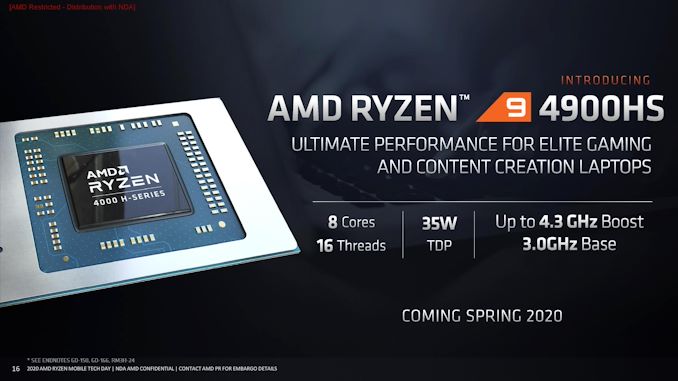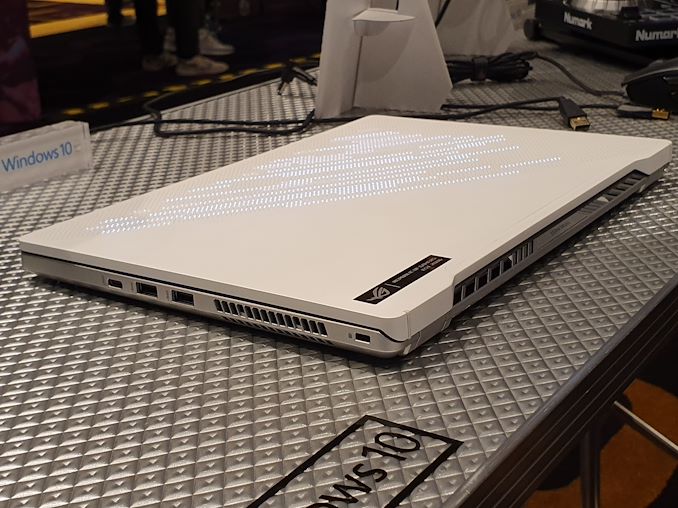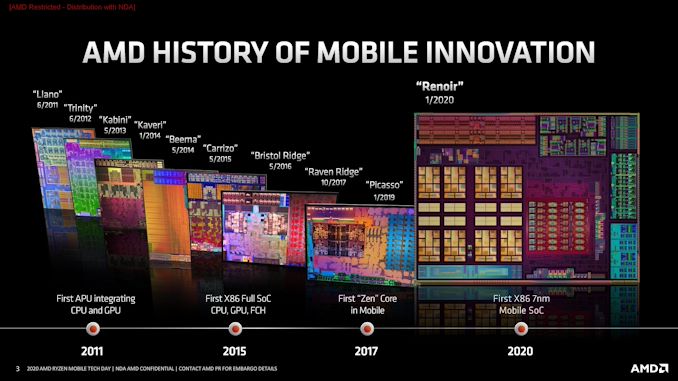AMD Announces Ryzen 9 4900H and 4900HS: The Halo 35 W and 45 W Mobile APUs
by Dr. Ian Cutress on March 16, 2020 9:00 AM EST- Posted in
- CPUs
- AMD
- APUs
- 35W
- 45W
- Ryzen Mobile
- Ryzen 9
- Ryzen 4000
- Ryzen 9 4900HS

As part of the disclosures on AMD’s Ryzen Mobile 4000 portfolio, the company is also lifting the lid on perhaps one of the worst kept secrets in mobile computing: the new top-of-the-line Ryzen 9 4900H family. This family consists of two processors, the standard H model built for 45 W operation, and the HS model at 35 W. These parts will offer more frequency and more graphics performance than the rest of AMD’s offerings, and are the only APUs from AMD to carry the weight of the Ryzen 9 branding.
We saw from AMD’s first announcement of its Ryzen Mobile 4000 family back in January that it was eager to attack the notebook market with its Zen 2-based 7nm products, featuring up to 8 cores and an updated Vega graphics engine. With the Zen 2 cores being a resounding success on the desktop in chiplet form, the monolithic APU market is where AMD has to ride over previous barriers to performance and marketability, and the belief in the company is that it will do so through 2020 with a combination of high performance x86 products delivering ‘superior’ graphics performance all while achieving multiple design wins. In January we saw several of those design wins in the flesh, such as the ASUS Zephyrus G14, the only 14-inch laptop with both a H-class processor and a discrete GPU, as well as an array of thin and light designs all based on the U-series family.

ASUS Zephyrus G14, with Ryzen 7 4800HS
The Ryzen 9 offerings from AMD are meant to be designated the best of the best, and one of the announcements missing in January was a mobile-class Ryzen 9 processor. Despite the lack of AMD mentioning one, it was a number of AMD’s OEM partners that spoke out of turn, showcasing various notebook designs with labels such as ‘Up to AMD Ryzen 9’ on the packaging, indicating that we were set to see a Ryzen 9 product in the portfolio. The official announcement is today, with the Ryzen 9 4900H and the Ryzen 9 4900HS.
| AMD Ryzen Mobile 4000 APUs | |||||||
| AnandTech | Cores Threads |
Base Freq |
Turbo Freq |
L2 | L3 | GPU CUs GPU Freq |
TDP |
| H-Series | |||||||
| Ryzen 9 4900H | 8 / 16 | 3.3 GHz | 4.4 GHz | 4 MB | 8 MB | 8 / 1750 MHz | 45 W |
| Ryzen 9 4900HS | 8 / 16 | 3.0 GHz | 4.3 GHz | 4 MB | 8 MB | 8 / 1750 MHz | 35 W |
| Ryzen 7 4800H | 8 / 16 | 2.9 GHz | 4.2 GHz | 4 MB | 8 MB | 7 / 1600 MHz | 45 W |
| Ryzen 7 4800HS | 8 / 16 | 2.9 GHz | 4.2 GHz | 4 MB | 8 MB | 7 / 1600 MHz | 35 W |
| Ryzen 5 4600H | 6 / 12 | 3.0 GHz | 4.0 GHz | 3 MB | 8 MB | 6 / 1500 MHz | 45 W |
| Ryzen 5 4600HS | 6 / 12 | 3.0 GHz | 4.0 GHz | 3 MB | 8 MB | 6 / 1500 MHz | 35 W |
| U-Series | |||||||
| Ryzen 7 4800U | 8 / 16 | 1.8 GHz | 4.2 GHz | 4 MB | 8 MB | 8 / 1750 MHz | 15 W |
| Ryzen 7 4700U | 8 / 8 | 2.0 GHz | 4.1 GHz | 4 MB | 8 MB | 7 / 1600 MHz | 15 W |
| Ryzen 5 4600U | 6 / 12 | 2.1 GHz | 4.0 GHz | 3 MB | 8 MB | 6 / 1500 MHz | 15 W |
| Ryzen 5 4500U | 6 / 6 | 2.3 GHz | 4.0 GHz | 3 MB | 8 MB | 6 / 1500 MHz | 15 W |
| Ryzen 3 4300U | 4 / 4 | 2.7 GHz | 3.7 GHz | 2 MB | 4 MB | 5 / 1400 MHz | 15 W |
AMD’s H processors have a TDP of 45 W, indicating that at sustained load (with enough temperature headroom), the CPU will run at 45 W, and try and take the best frequency it can at 45 W.
The HS processors are a bit different to the H processors. They mostly have the same frequencies (except the Ryzen 9), but are labelled as 35 W in the default configuration. That means it will still try and aim for the best frequency, but the sustained power consumption is only 35 W. Not everyone can buy the HS processor – AMD reserves these parts for OEM partners that it works in tandem with to give the best experience. The first HS system into the market will be that ASUS Zephyrus G14, and that system will have a short exclusivity on the Ryzen 7 version parts.
Note that the normal H processors can also be set at 35 W by the OEM, but that won’t make them a HS processor – the S means that AMD has validated the design, and AMD has the units in house and pre-tests any updates to the notebooks before the updates get released. This comes from AMD’s two Continuous Validation Labs, one in Austin and one in Shanghai. We (the press) postulated that the ‘HS’ stands for ‘High School’, with these parts being targeted for the back-to-school designs. AMD corrected us, saying that the H is just the class, and the S stands for Special.
With regards the Ryzen 9 processors, AMD initially actually only gave us the specifications of the 4900HS, with the 4900H ‘to be disclosed'. This could have been for two reasons – firstly that the 4900HS might be the only model we’ll see, that AMD wants to keep it for those designs formed from collaboration with OEMs, or secondly that it’s a high enough binning of a chip that they want to dedicate the first batches to those collaborations. In the end, the day before this announcement, we discovered the details in the latest version of the slide decks. Nonetheless, the Ryzen 9 4900HS sits +100 MHz above the Ryzen 7 parts, with one extra compute unit and +150 MHz on the graphics frequency, and the Ryzen 9 4900H is +300 MHz on the base over the 4900HS, and +100 MHz on the turbo. All the parts are PCIe 3.0, for power reasons.
The Ryzen 9 4900H and Ryzen 9 4900HS are expected to hit the market in the Spring (Q2?) of 2020. Given the recent global situation, it might be out in China before it comes to the rest of the world.











37 Comments
View All Comments
0ldman79 - Monday, March 16, 2020 - link
Laptop usage on battery is usually light use. You're not going to encode a video or render something on battery.In those situations early Ryzen kick ass.
In light usage, Intel can drop down to below 1W, Ryzen 2000 and 3000 mobile idle at around 4.5W. Skylake uses 2W to watch a 1080P video.
That's a huge difference on light usage battery life.
webdoctors - Monday, March 16, 2020 - link
Here's another AMD announcement you can cover:Advanced Micro Devices (AMD) – AMD has over 2,000 employees in Austin and all will be required to work on-site, with no talk of any remote work in the future. Several employees expressed discomfort not only due to the size of the campus, but for no restrictions on travel with staff traveling from Europe as recently as last week prior to the travel
https://theamericangenius.com/business-news/covid-...
They really don't care about spreading the virus.
PeachNCream - Monday, March 16, 2020 - link
That is not just an AMD thing. Companies are trying to coordinate work from home where possible, but certain things cannot be done from an employee's residence. It is a difficult decision to make and there really isn't a one-size-fits-all answer to COVID-19 response. Lots of this is being played by ear since we have no modern examples of how to handle situations like these. Nothing like this has happened on a global scale to post-industrial nations and their respective economies.Irata - Monday, March 16, 2020 - link
Correct - the infrastructure to do this securely must be set up and that is not an easy task. How about time keeping, insurance etc ?Irata - Monday, March 16, 2020 - link
From the article that covers many Austin companies with the same issue:„ Since publication, a handful of staff have told us AMD has responded, and as of today, they are now globally “work from home whenever possible,” for at least two weeks, but previously, it was at manager’s discretion. One employee told us “many managers were not willing,” so this company-wide push to work from home makes willingness irrelevant.“
watzupken - Sunday, March 22, 2020 - link
I agree some work just cannot be done offsite, and with all these product secrecy, it adds to the need for employees to work onsite. It is definitely not ideal, but I feel companies requiring large number of people onsite is also taking a big risk since 1 sick person in the building can spread to many in the compound. I don't know the actual reason why, but I will not jump to any conclusion here.minakami_yuki - Sunday, March 29, 2020 - link
HS means HuaShuo, the chinese name of ASUS